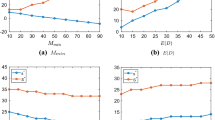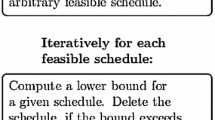Abstract
We consider a production planning problem with two planning periods. Detailed planning occurs in the first period, when complete information is known about a set of orders that are initially available. An additional set of orders becomes available at the start of the second planning period. The objective is to maximize the number of on-time orders. We derive an upper bound on the competitive ratio of any deterministic online algorithm, relative to the performance of an algorithm with perfect information about the second set of orders. This ratio depends on the relative lengths of the two planning periods. We also describe an efficient algorithm that delivers a solution which asymptotically achieves this upper bound ratio as the number of jobs becomes large.
Similar content being viewed by others
References
Baptiste, P. (1999). An \(O(n^4)\) algorithm for preemptive scheduling of a single machine to minimize the number of late jobs. Operations Research Letters, 24, 175–180.
Bean, J. C., Birge, J. R., Mittenthal, J., & Noon, C. E. (1991). Matchup scheduling with multiple resources, release dates and disruptions. Operations Research, 39, 470–483.
Blum, M., Floyd, R. W., Pratt, V. R., Rivest, R. L., & Tarjan, R. E. (1972). Time bounds for selection. Journal of Computer and System Sciences, 7, 448–461.
Chand, S., Hsu, V. N., & Sethi, S. (2002). Forecast, solution and rolling horizons in operations management problems: A classified bibliography. Manufacturing & Service Operations Management, 4, 25–43.
Chrobak, M., Jawor, M., Sgall, J., & Tichy, T. (2006). Online scheduling of equal-length jobs: Randomization and restarts help. SIAM Journal on Computing, 36, 1709–1728.
Ciarallo, F. W., Akella, R., & Morton, T. E. (1994). A periodic review, production planning model with uncertain capacity and uncertain demand—optimality of extended myopic policies. Management Science, 40(3), 320–332.
Fung, S. P. Y. (2008). Lower bounds on online deadline scheduling with preemption penalties. Information Processing Letters, 108, 214–218.
Geunes, J., Merzifonluoğlu, Y., Romeijn, H.E., & Taaffe, K. (2005). Demand selection and assignment problems in supply chain planning. Tutorials in Operations Research, INFORMS, pp. 124–141.
Graham, R. L. (1966). Bounds for certain multiprocessor anomalies. Bell System Technical Journal, 45, 1563–1581.
Hall, N. G., Posner, M. E., & Potts, C. N. (2009). Online scheduling with known arrival times. Mathematics of Operations Research, 34, 92–102.
Hoogeveen, H., Potts, C. N., & Woeginger, G. J. (2000). On-line scheduling on a single machine: Maximizing the number of early jobs. Operations Research Letters, 27, 193–197.
Ignall, E., & Veinott, A. F, Jr. (1969). Optimality of myopic inventory policies for several substitute products. Management Science, 16, 284–304.
Jackson, J. R. (1955). Scheduling a production line to minimize maximum tardiness. Research Report 43, Management Science Research Project, University of California, Los Angeles, CA.
Lawler, E. L. (1983). Scheduling a single machine to minimize the number of late jobs. Technical report, University of California at Berkeley, Berkeley, CA.
Lenstra, J. K., Rinnooy Kan, A. H. G., & Brucker, P. (1977). Complexity of machine scheduling problems. Annals of Operations Research, 1, 343–362.
Li, C., & Zhang, F. (2013). Advance demand information, price discrimination, and preorder strategies. Manufacturing & Service Operations Management, 15(1), 57–71.
McClain, J., & Thomas, L. J. (1977). Horizon effects in aggregate production planning with seasonal demands. Management Science, 23, 728–736.
Modigliani, F., & Hohn, F. E. (1955). Production planning over time and the nature of the expectation and planning horizon. Econometrica, 23, 46–66.
Moore, J. M. (1968). An \(n\) job, one machine sequencing algorithm for minimizing the number of late jobs. Management Science, 15, 102–109.
Pinedo, M. L. (2012). Scheduling: Theory, algorithms and systems (4th ed., p. 2012). Berlin: Springer.
Pruhs, K., Sgall, J., & Torng, E. (2004). Online scheduling. In J. Y.-T. Leung (Ed.), Handbook of scheduling: Algorithms, models and performance analysis. Boca Raton, FL: CRC Press.
Reid, R. D., & Sanders, N. R. (2005). Operations management: An integrated approach (2nd ed.). Hoboken, NJ: Wiley.
Russell, R. S., & Taylor, B. W, I. I. I. (2006). Operations management: Quality and competitiveness in a global environment (5th ed.). Hoboken, NJ: Wiley.
Smith, W. E. (1956). Various optimizers for single stage production. Naval Research Logistics Quarterly, 3, 59–66.
Zhao, X., & Stecke, K. E. (2010). Pre-orders for new to-be-released products considering consumer loss aversion. Production and Operations Management, 19(2), 198–215.
Zheng, F. F., Xu, Y. F., & Zhang, E. (2007). On-line production order scheduling with production order penalties. Journal of Combinatorial Optimization, 13, 189–204.
Zheng, F. F., Xu, Y. F., & Zhang, E. (2008). How much can lookahead help in online single machine scheduling. Information Processing Letters, 106, 70–74.
Acknowledgements
This research is supported in part by National Science Foundation Grant DMI-0421823, and by the Summer Fellowship Program of the Fisher College of Business, The Ohio State University, to the first author.
Author information
Authors and Affiliations
Corresponding author
Rights and permissions
About this article
Cite this article
Hall, N.G., Posner, M.E. & Potts, C.N. Online production planning to maximize the number of on-time orders. Ann Oper Res 298, 249–269 (2021). https://doi.org/10.1007/s10479-018-2928-6
Published:
Issue Date:
DOI: https://doi.org/10.1007/s10479-018-2928-6




